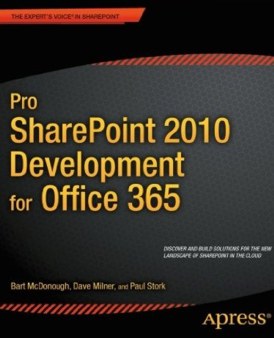| Pro SharePoint 2010 Development for Office 365 |
|
Author: Bart McDonough, Dave Milner & Paul Stork
This is a book aimed at .NET and ASP.NET developers who are beginners in their knowledge of both SharePoint and Office 365, but who now need to customize the cloud-based suite. The book provides a clear if restricted introduction to this, though anyone with SharePoint experience would find it of limited use.
The authors start with an intro to Office 365 and SharePoint Online, before going on to discuss the three ways to customize SharePoint Online - through the browser, using Visual Studio, and using client-side coding with SharePoint Designer. There’s a chapter on setting up a development environment for SharePoint Online, though some of this seemed to me somewhat of a waste of space. If you’re a .NET developer, you hopefully already have Visual Studio set up and working, and are already familiar with virtual machines. The rest of the chapter - creating a local setup of SharePoint 2010, Designer 2010, and an HTML editor was more useful. Chapter 4 takes you through the options available if you’re customizing using only a browser for minimal changes such as site settings, themes, and simple lists. The more sophisticated options of SharePoint Designer are tackled next, and the authors show how to use web parts and XSLT to customize the display of data. The chapter also covers accessing external data using Business Connectivity Services, and introduces building declarative workflows.
One decision you face when customizing SharePoint is how to create forms for displaying data, and one choice open to you is InfoPath. I have to admit to thinking in the past that InfoPath would be one of the Microsoft products that appears, looks promising, then vanishes just as you start relying on it, but it’s still around in the higher editions of Office, and McDonough et al. rate it. The chapter on InfoPath gives space to a list of the controls and objects you can use in InfoPath, then moves on to showing how to use InfoPath forms instead of SharePoint list and library forms. The chapter closes with a brief look at workflows and InfoPath. Visual Studio development gets its own chapter, and after discussing sandboxed solutions the authors move on to looking at creating features, feature receivers, web parts, event receivers, content types, and custom actions. There’s also a short description of packaging and deploying the solution. I’d have preferred more space to be dedicated to VS development, as some of the descriptions are short and there isn’t enough discussion of why you’d want to develop things such as web parts or feature receivers. There is some code in this chapter, and the material is well written. Chapter 8 moves on to SharePoint Designer Workflows, and in particular how you can now create them in Designer 2010. Workflows are the customization object of choice of most SharePoint power users because you can achieve results without needing to talk to the IT department, so have something of a mixed reputation as far as most IT departments are concerned. However, new workflow designer in Designer makes the task easier. The chapter shows how to use the new facility and works through building and deploying a workflow before looking at integrating with Visio, and gives links on a couple of articles showing how to develop custom actions with Visual Studio. Client side development gets its own chapter, with coverage of using REST-ful services and using the ASP.NET web services. There are three APIs within the client object model - managed .NET, Silverlight, and JavaScript, but the authors say the experience of using all of them is similar enough for you to move between them without trouble, and they illustrate this with examples of using the ClientContext object from each of the APIs. The rest of the chapter looks at authentication, creating and retrieving items, then updating and deleting list items. There’s a chapter on client-side development with Silverlight, and another on developing with jQuery, HTML5, and CSS3. Both cover building and deploying using the different development environments, though the jQuery chapter devotes space to introducing HTML5 and CSS3, and gives less space to the actual development process. The book closes with an appendix on hybrid on-premises/online solutions. I think your view of this book will depend on where you are in your knowledge of SharePoint and of development options such as Visual Studio and jQuery. As an introductions showing what you can use to work with SharePoint Online, it’s reasonably good, and will give you a good idea of what your options are. For more experienced developers, there’s wasted space taken with describing topics such as why virtual machines are a good idea, what HTML5 and CSS offer, and how to create a project in Visual Studio. Despite the title, there’s little on the ‘office’ parts of Office 365. This is really a book introducing SharePoint Online and the options for customizing it.
|
|||
| Last Updated ( Thursday, 14 February 2013 ) |

